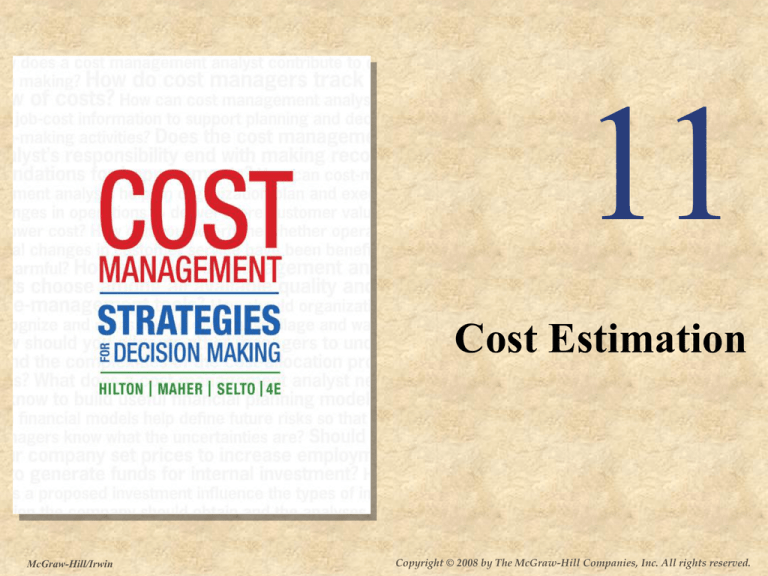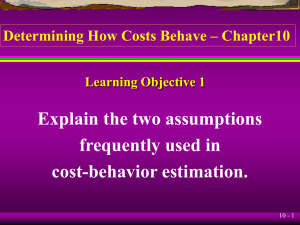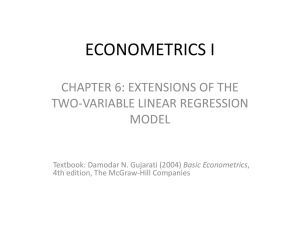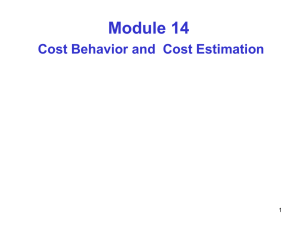
11
Cost Estimation
McGraw-Hill/Irwin
Copyright © 2008 by The McGraw-Hill Companies, Inc. All rights reserved.
11-2
Introduction
Cost
behavior
Cost
estimation
Cost
prediction
Existing
relationship
between
cost and
activity.
Process of
estimating
relationship
between costs
and cost driver
activities that
cause
those costs.
Using results of
cost estimation
to forecast a
level of cost at
a particular
activity. Focus
is on the future.
11-3
Learning Objective 1
11-4
Reasons for Estimating Costs
What will my
costs be if I introduce
the new model in a
foreign market?
Management needs
to know the costs that
are likely to be
incurred for each
alternative.
How much
will costs increase
if sales increase
10 percent?
11-5
Reasons for Estimating Costs
More accurate
cost estimates
Better informed decisions about:
• efficient business processes
• alternative courses of action
• performance standards
• financial forecasts
Increased
company
value
Exh.
11-1
11-6
Reasons for Estimating Costs
1. First
identify this
Relationship
between
activities
and costs
3. To reduce
these
Costs
We estimate
costs to:
2. Then
manage these
Activities
manage costs
make decisions
plan and set
standards.
11-7
Basic Cost Behavior Patterns
Summary of variable and fixed cost behavior
Cost
In total
Per unit
Variable
Total variable cost changes
as activity level changes.
Variable cost per unit remains
the same over wide ranges
of activity.
Fixed
Total fixed cost remains the
same even when the activity
level changes.
Fixed cost per unit goes
down as activity level goes up.
Total Costs = Fixed costs + Variable costs
TC = F + VX
V is the variable cost per cost driver unit (cost driver rate).
X is the number of cost driver units.
11-8
Learning Objective 2
Exh.
11-2
11-9
One Cost Driver and Fixed/Variable
Cost Behavior
TC = $190 + (.16 x Miles Driven)
$600
510
$500
Cost
$400
350
$300
$200
190
$.16
Slope = Cost
Driver Rate
Intercept = Fixed
Cost
$100
$0
0
1000
2000
Miles driven per month
3000
11-10
Multiple Cost Drivers and Complex
Cost Behavior
In cases of complex
cost behavior and
multiple cost drivers,
the cost-benefit test
should be considered
when developing a
cost estimation
model.
11-11
Step Costs
•A cost that
increases in steps
as the amount of the
cost driver volume
increases.
•Also called a
“semifixed cost”
Cost
Step Cost
Activity
Total cost remains
unchanged over a narrow
range of activity. As
activity increases to the
next range, total cost
steps up to the next level.
11-12
Step Costs
Example: Office space is
available at a rental rate
of $30,000 per year in
increments of 1,000
square feet. As the
business grows more
space is rented,
increasing the total cost.
Continue
11-13
Step Costs
$90,000
Total cost remains
unchanged for a
range of activity,
then jumps to a
higher cost for the
next range of activity.
$60,000
$30,000
0
1,000
2,000
3,000
Rented Area (Square Feet)
11-14
Relevant Range of Activity
Unit variable costs
remain unchanged.
The activity limits within which a
cost projection may be valid is
the relevant range of activity.
Total fixed costs
remain unchanged.
11-15
Mixed Costs
A mixed cost is one
that has both a
fixed and a variable
component.
Exhibit 11-4: Mixed Cost Example
80
Cost
60
40
20
0
0
200
400
600
Minutes per month
800
1000
For example, a
cellular phone plan
that charges $40 for
the first 600
minutes and $0.10
per minute
thereafter.
11-16
Nonlinear Costs
Total Cost
Curvilinear
Cost Function
Relevant Range
Activity
A nonlinear cost
pattern (e.g. changes
in unit variable cost)
may often approximate
a straight line (when
the unit variable cost is
constant) within the
relevant range.
11-17
Methods of Estimating Costs
Scattergraph and high-low estimates
Statistical methods (regression analysis)
Account analysis
Engineering method
11-18
The Scattergraph
Simply plotting past cost behavior on a graph
may be a helpful first step in analyzing costs
regardless of the estimation method
ultimately chosen.
It can reveal outlier data points and suggest
possible relationships between the variables.
11-19
The Scattergraph
Plot the data points on a
graph (total cost vs. activity).
$20,000
$10,000
* *
* *
* ** *
**
0
0
1
2
3
4
Activity: Units produced (‘000)
11-20
The Scattergraph
Draw a line through the plotted data points so that about
an equal amount of points falls above and below the line.
$20,000
$10,000
* *
* *
* ** *
**
Estimated fixed cost = $10,000
0
0
1
2
3
4
Activity: Units produced (‘000)
11-21
The Scattergraph
The slope of this line is the unit variable cost. (Slope is
the change in total cost for a one-unit change in activity).
Total Cost
$20,000
$10,000
* *
* *
* ** *
**
Horizontal distance is
the change in activity.
0
0
1
2
3
4
Activity: Units produced (‘000)
Vertical
distance
is the
change
in cost.
11-22
The High-Low Method
The high-low method uses two data points to
estimate the general cost equation TC = F VX
TC = the estimated total cost
F = a fixed quantity that represents
the value of Y when X = zero
V = the slope of the line
(equivalent to the unit variable cost)
X = units of the cost driver activity
11-23
The High-Low Method
The high-low method uses two
data points to estimate the general
cost equation TC = F + VX
$20,000
$10,000
* *
* *
* ** *
**
The two points should be representative of
the cost and activity relationship over the range
of activity for which the estimation is made.
0
0
1
2
3
4
Activity: Units produced (‘000)
11-24
The High-Low Method
WiseCo recorded the following production activity
and maintenance costs for two months:
High activity level
Low activity level
Change
Units
9,000
5,000
4,000
Cost
$ 9,700
6,100
$ 3,600
Using these two levels of activity, compute:
the variable cost per unit;
the fixed cost; and then
express the costs in equation form TC = F + VX.
11-25
The High-Low Method
High activity level
Low activity level
Change
Units
9,000
5,000
4,000
Cost
$ 9,700
6,100
$ 3,600
Unit variable cost = $3,600 ÷ 4,000 units = $.90 per unit
Fixed cost = Total cost – Total variable cost
Fixed cost = $9,700 – ($.90 per unit × 9,000 units)
Fixed cost = $9,700 – $8,100 = $1,600
Total cost = Fixed cost + Variable cost (TC = F + VX)
TC = $1,600 + $0.90X
11-26
Learning Objective 3
11-27
Regression Analysis
A statistical method used to create an
equation relating dependent (or Y) variables
to independent (or X) variables.
Data from the past are used to estimate
relationships between costs and activities.
Independent variables
are the cost drivers that
drive the variation in
dependent variables.
Before doing the
analysis, take time to
determine if a logical
relationship between the
variables exists.
11-28
Regression Analysis
The objective of the regression method is still a
linear equation to estimate costs TC = F + VX
TC = value of the dependent variable
(estimated total cost)
F = a fixed quantity, the intercept, that
represents the value of TC when X = 0
V = the unit variable cost, the coefficient of
the independent variable measuring the
increase in TC for each unit increase in X
X = value of the independent variable, the cost driver
11-29
Regression Analysis
A statistical procedure that finds the unique line
400
through data points that minimizes the sum of
squared distances from the data points to the line.
350
300
250
200
50
100
150
Independent Variable
200
11-30
Regression Analysis
400
V = the slope of the regression line or the
coefficient of the independent variable. Here
it represents the increase in TC for each unit
increase in X.
350
300
250
200
F = a fixed quantity, the intercept
50
100
150
Independent Variable
200
11-31
Regression Analysis
proper line, excluding the outlier
improper line, influenced by outlier
400
350
300
250
Outlier
Outliers may be discarded to
obtain a regression that is more
representative of the data.
200
50
100
150
Independent Variable
200
11-32
Regression Analysis
The correlation coefficient (r) is a measure of the linear
relationship between variables such as cost and activity.
Total Cost
$20,000
* *
* *
$10,000
* ** *
**
The correlation coefficient is highly
positive (close to 1.0) if the data points
are close to the regression line.
0
0
1
2
3
4
Activity: Units produced (‘000)
11-33
Regression Analysis
The correlation coefficient (r) is a measure of the linear
relationship between variables such as cost and activity.
Total Cost
*
$20,000
*
$10,000
*
*
*
*
*
*
*
*
The correlation coefficient is near
zero if little or no relationship
exists between the variables.
0
0
1
2
3
4
Activity: Units produced (‘000)
11-34
Regression Analysis
The correlation coefficient (r) is a measure of the linear
relationship between variables such as cost and activity.
*
$20,000
$10,000
* *
*
*
*
*
* *
*
This relationship has a negative
correlation coefficient, approaching
a maximum value of –1.0
0
0
1
2
3
4
Activity: Units produced (‘000)
11-35
Regression Analysis
400
R2, the coefficient of determination, is a measure
of the goodness of fit. R2 tells us the amount
of the variation of the dependent variable that
is explained by the independent variable.
350
300
250
Regression with
high R2 (close to 1.0)
200
50
100
150
Independent Variable
200
11-36
Regression Analysis
400
The coefficient of
determination, R2,
is the correlation
coefficient squared.
350
300
250
Regression with
low R2 (close to 0)
200
50
100
150
Independent Variable
200
11-37
Regression Analysis
Includes all data points,
resulting in more thorough
study of the relationship
between the variables.
Generates statistical
information that describes
the relationship between
variables.
Permits the use of more
than one cost driver activity
to explain cost behavior.
11-38
Regression Analysis
Statistics courses deal
with detailed regression
computations using
computer spreadsheet
software.
Accountants and
managers must be able
to interpret and use
regression estimates.
Let’s look at an example
using Excel.
11-39
Simple Regression Example
Eagle Enterprises
wants to analyze
the relationship
between units
produced and total
costs.
Using the data to
the right, let’s see
how to do a
regression using
Excel.
Month
January
February
March
April
May
June
July
August
September
October
November
December
January
February
March
April
Total Costs
$
6,720
7,260
7,270
11,060
12,580
8,660
8,580
9,550
13,050
11,060
7,320
7,370
6,790
7,480
6,990
11,400
Units
1,280
1,810
1,620
2,830
3,630
2,610
2,460
2,640
3,620
2,840
1,820
1,650
1,260
1,850
1,710
2,940
11-40
Simple Regression Using Excel
We will obtain three pieces
of information from our
regression analysis:
1. Estimated Variable Cost
per Unit (line slope)
2. Estimated Fixed Costs
(line intercept)
3. Goodness of fit, or R2
To get these three pieces of
information we will need to
find the following Excel
functions: LINEST,
INTERCEPT and RSQ.
Month
January
February
March
April
May
June
July
August
September
October
November
December
January
February
March
April
Total Costs
$
6,720
7,260
7,270
11,060
12,580
8,660
8,580
9,550
13,050
11,060
7,320
7,370
6,790
7,480
6,990
11,400
Units
1,280
1,810
1,620
2,830
3,630
2,610
2,460
2,640
3,620
2,840
1,820
1,650
1,260
1,850
1,710
2,940
11-41
Simple Regression Using Excel
After opening
Excel and
entering your
data, click on
“Insert” and
“Function”
11-42
Simple Regression Using Excel
When the
function box
opens, click
on
“Statistical”,
then on
“LINEST”
11-43
Simple Regression Using Excel
By clicking on the
buttons to the
left, you can
highlight the
desired cells
directly from the
spreadsheet.
1. Enter the cell range for the cost amounts in the
“Known_y’s” box.
2. Enter the cell range for the quantity amounts in
the “Known_x’s” box.
11-44
Simple Regression Using Excel
The Slope, or estimated variable cost per unit, is
identified here. Click OK to put this value on your
spreadsheet.
11-45
Simple Regression Using Excel
Repeat the
procedure
using
“Intercept”,
to estimate
fixed cost.
11-46
Simple Regression Using Excel
The estimated fixed cost per unit is
identified here.
As previously,
enter the
appropriate cell
ranges in their
appropriate
places.
11-47
Simple Regression Using Excel
Finally,
determine the
“goodness of
fit”, or R2, by
using the RSQ
function.
11-48
Simple Regression Using Excel
The estimated R2 for your estimated
cost function is identified here.
As previously,
enter the
appropriate cell
ranges in their
appropriate
places.
11-49
Simple Regression
Example Summary
The objective of the regression method is a
linear equation to estimate costs TC = F + VX
We found the following linear equation for Eagle:
TC = $2,618.72 + $2.768 per unit
The high value for R2 tells us that approximately
93.26 percent of the variation in total cost
is explained by the variation in the number of
units produced.
11-50
Multiple Regression Analysis
Multiple Regression is a
regression that has more than
one independent (X) variable.
Can be very useful in
situations where the
dependent variable is
impacted by several
different independent
variables.
For example, demand
for a product may be
affected by factors
such as inflation,
interest rates and
competitors’ prices.
11-51
Multiple Regression Analysis
Terms in the equation have the same
meaning as in a simple regression.
Here there are two or more independent
variables instead of only one.
TC = F + V1X1 + V2X2
Each additional independent variable increases
the proportion of explained variation (R2)
which is then adjusted for the number of
independent variables.
11-52
Regression Analysis
Let me give you some
pointers on
regression analysis.
A logical relationship
must be established
between the variables.
Entering data into the
analysis that have no
logical relationship
will result in
meaningless
estimates.
11-53
Regression Analysis
Let me give you some
pointers on
regression analysis.
Data points that vary
significantly from the
regression line (outliers)
draw the regression line
away from the majority
of data points.
The least squares
procedure minimizes
the sum of squares of
the distances from
the data points to the
line.
11-54
Regression Analysis
Let me give you some
pointers on
regression analysis.
The intercept term
should be used with
caution to estimate
fixed cost.
The intercept is likely
to be outside the
relevant range of
observations as it
occurs at an activity
level of zero.
11-55
Regression Analysis
Let me give you some
pointers on
regression analysis.
A regression equation
may be a poor
predictor of future
costs if . . . .
Cost-activity
relationships have
changed.
Costs themselves
have changed
independently of
changes in activity.
11-56
Regression Analysis –
Utilization Problems
Regression results are questionable when:
Attempting to fit a linear
equation to nonlinear
data
Failing to exclude
outliers
Including variables
that have apparent but
spurious relationships
11-57
Regression Analysis Data Problems
Mismatched
Time Periods
Missing
Data
Inflation
Allocated
Costs
11-58
Learning Objective 4
11-59
Account Analysis
Cost estimates are based on a
review of each activity account making up
the total cost being analyzed.
Objective: Relate costs and activity in
the form of the general cost equation:
TC = F + VX
11-60
Account Analysis
Identify cost drivers and the costs associated with each
driver.
Sum the fixed costs (facility costs).
Sum the variable costs for each cost driver activity.
Divide the total variable costs for each cost driver
activity by the total number of cost driver units to obtain
variable cost per unit.
Divide the fixed costs by the number
of time periods in the data.
Objective: TC = F + VX
11-61
Account Analysis - Example
Account
Indirect Labor
Indirect Material
Depreciation
Property Taxes
Insurance
Utilities
Maintenance
Totals
Overhead
Total
Cost
$
450
700
1,000
200
300
400
600
$ 3,650
Costs for 1,000 Units
Variable
Fixed
Cost
Cost
$
450
700
1,000
200
300
350
50
500
100
$ 2,000
$ 1,650
V = $2,000 ÷ 1,000 units = $2 per unit
TC = $1,650 + $2 per unit
11-62
Account Analysis - Example
Estimate the total overhead cost for 1,400 units
using the cost relationship from the the preceding
example.
a.
b.
c.
d.
$3,300
$4,450
$3,650
$5,650
11-63
Account Analysis - Example
Estimate the total overhead cost for 1,400 units
using the cost relationship from the the preceding
example.
a.
b.
c.
d.
$3,300
$4,450
$3,650
$5,650
TC = F + VX
TC = $1,650 + ($2 × 1,400 units)
TC = $1,650 + $2,800 = $4,450
11-64
Learning Objective 5
11-65
Engineering Method
Engineering estimates of
cost are made, based on:
• Measurement of work
involved in the activities
that go into a product.
• Assigning a cost to each
of the activities.
Past costs
are not
taken into
account.
11-66
Engineering Method
Direct Labor
Direct Material
•Analyze the kind
of work performed.
•Estimate the time
required for each labor
skill for each unit.
•Material required
for each unit is
obtained from
engineering drawings
and specification sheets.
•Use local wage rates to
obtain labor cost
per unit.
•Material prices are
determined from
vendor bids.
11-67
Engineering Method
Overhead costs are obtained in a similar
manner – a detailed step-by-step analysis of the
work involved.
Advantages of the engineering approach:
Detailed analysis results in better knowledge of the
entire process.
The method is used to estimate costs of new
activities. Data from prior activities are not required.
A disadvantage of the engineering approach is
the high cost of detailed analysis.
11-68
Choice of an Estimation Method
Regression and
account
analysis rely on
past data. The
engineering
method relies
on present data.
Each method
will likely
yield a
different
estimate.
Cost/Benefit
must be
considered in
choosing a
method.
11-69
Choice of an Estimation Method
No single method is best for all situations.
Better results are often obtained by use of
several of the methods. For example:
Engineering estimates and account analysis may
lead to the establishment of logical, causal
relationships between variables.
A scattergraph plot will lead to a better
understanding of the relationship and may reveal
outlier data points.
Regression provides a cost equation for the data
points with statistical measures of fit.
11-70
Use of the Results
Cost estimation provides important information for forecasting:
Levels of demand under different prices
Success of new products/services
Adequacy of present production and office
facilities; feasibility of outsourcing
Overall profitability under many cost and
price scenarios
Just keep in mind
the limitations of
these estimation techniques!
11-71
Learning Objective 6
11-72
Issues in Using Regressions
This technique does not provide exact
measurements. It yields good approximations of the actual relationships between
cost drivers and costs.
There is seldom 100% confidence about a
relationship between dependent and
independent variables.
It cannot be always assumed that the cost
estimation errors are normally distributed,
independent and with constant variation.
So-called independent variables may be in
fact closely correlated.
11-73
Learning Objective 7
11-74
Learning Curve
Time
The learning phenomenon:
as we gain in experience,
we take less time to
perform a task.
Repeated tasks
$
For cost estimation:
as cost driver activity increases,
the learning phenomenon leads
to lower costs per unit and
greater profitability.
Minimum profit
Incremental profit
Output
11-75
End of Chapter 11










